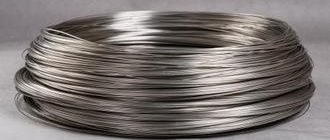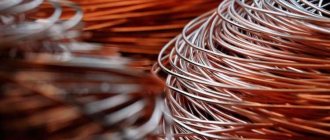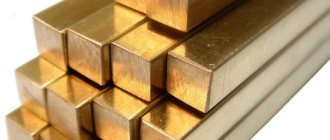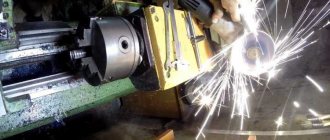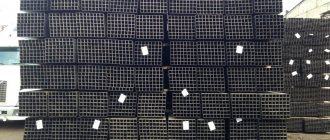Method for producing cold-rolled cold-worked steel sheets
Owners of patent RU 2369456:
The method is intended to improve the consumer properties of low-carbon cold-rolled cold-worked steel sheets with a cross-section of 0.43...0.63×1250 mm. The method involves rolling a hot-rolled strip billet in the rolls of a broadband mill with specified reductions. The production of sheet steel having the properties of cold-worked metal, suitable for subsequent galvanizing, is ensured by the fact that rolling is carried out on a two-stand reversible mill with a relative total reduction in the range of 69...79%, while the reduction value in the last pass is taken equal to 56...60% from compression in the first pass, and the value of the specific tension is in the range of 75...85 N/mm 2 with an additional tension of no more than 20 N/mm 2.
The invention relates to rolling production and can be used in the production of cold-rolled sheets of hard-worked steel.
Cold-worked steel is surface-hardened steel, processed without its complete recrystallization (see “Explanatory Metallurgical Dictionary”, edited by V.I. Kumanin, M., “Metallurgy”, 1989, pp. 177 and 179). Cold-worked sheet steel is produced by cold rolling, the technology of which is described in sufficient detail, for example, in the book by P.I. Polukhin et al. “Rolling production”, M., “Metallurgy”, 1982, pp. 511-535.
Cold-worked steel
Modern mechanical engineering, as well as the production of various metal products, requires steel as a material, which has completely different physical and mechanical qualities.
In this case, it is of great importance to manufacture such grades of steel, the surface of which has the same mechanical qualities, and the main body of the product - somewhat different. In particular, for many areas of mechanical engineering it is important that steel retains its basic plastic qualities such as strength and elasticity, but at the same time acquires the hardness of surface layers that directly interact with other elements of machines or structures. Individual components of machines and mechanisms require increased impact resistance of the steel surface, increased resistance to wear, as well as increased resistance to micro-fractures, which are commonly called “material fatigue.”
Steel acquires all these properties in the technological process of cold hardening, which is also known as cold hardening. Cold hardening (hardening) is the process of plastic deformation of a steel workpiece at temperatures when the size of the steel “grain” does not increase during the heating process, that is, recrystallization does not occur. During this process, the hardness and strength of the surface layers of the workpiece increases by reducing their viscosity and ductility. There is an opinion that any external mechanical effect on a steel workpiece can be called “hardening”, however, the quality of the technological procedure of hardening depends on a significant number of conditions, primarily on temperature.
Cold hardening in modern production conditions is carried out both in phases - due to a complex procedure for heat treatment of steel, and mechanically - due to deforming external influences. External deforming action is, as a rule, the result of “shelling” a steel workpiece with a stream of steel or cast iron shot. The mechanism of this impact can be different - using a special rotary shot blaster, air flow, etc.
It is important to know that to produce high-quality cold-worked steel, strict adherence to cold-working technology is necessary. Excessive or other improper thermal or mechanical effects on a steel workpiece during the work hardening process can lead to over hardening - a condition of the steel surface on which microcracks and pores appear, which cause its brittleness. That is why, when looking for options for purchasing batches of cold-worked steel, special attention should be paid to the reliability and production and business reputation of its manufacturer.
Source
method for producing cold-rolled cold-worked steel sheets
The method is intended to improve the consumer properties of low-carbon cold-rolled cold-worked steel sheets with a cross-section of 0.43-0.63×1250 mm. The method involves rolling a hot-rolled strip billet in the rolls of a broadband mill with specified reductions. The production of sheet steel having the properties of cold-worked metal, suitable for subsequent galvanizing, is ensured by the fact that rolling is carried out on a two-stand reversible mill with a relative total reduction in the range of 69-79%, while the reduction value in the last pass is taken equal to 56-60% of the reduction in the first pass, and the value of the specific tension is in the range of 75 85 N/mm 2 with an additional tension of no more than 20 N/mm 2.
The invention relates to rolling production and can be used in the production of cold-rolled sheets of hard-worked steel.
Cold-worked steel is surface-hardened steel, processed without its complete recrystallization (see “Explanatory Metallurgical Dictionary”, edited by V.I. Kumanin, M., “Metallurgy”, 1989, pp. 177 and 179). Cold-worked sheet steel is produced by cold rolling, the technology of which is described in sufficient detail, for example, in the book by P.I. Polukhin et al. “Rolling production”, M., “Metallurgy”, 1982, pp. 511-535.
There is a known method of cold rolling of thin-sheet steel, in which a cutting fluid containing palm oil is supplied to specified intervals of a continuous mill, and the oil is repeatedly used in the circulation cycle of the cutting fluid with a given fat content and specific consumption (see RF Patent No. 2288791 , class B21B 1/28, published BI No. 34, 2006). However, this method is unsuitable for producing cold-worked sheet steel.
The closest analogue to the claimed method is the technology of cold rolling of sheet steel, described in the book by V.F. Zotov and V.I. Elin “Cold rolling of metal”, M., “Metallurgy”, 1988, pp. 165-179.
This technology consists of rolling a hot-rolled strip billet in the rolls of a continuous mill with given reductions and is characterized by the fact that the value of the total reduction is taken depending on the final thickness of the strips within 42-85%, and the value of the specific tensions is adjusted to 0.6-0.7 from the limit fluidity of rolled metal.
The use of known technology for the production of cold-rolled cold-rolled steel is very difficult due to the lack of specification of reduction and tension values, which will not allow obtaining the required consumer properties of the finished product.
The technical objective of the present invention is to improve the consumer properties of low-carbon sheet steel intended for subsequent galvanizing.
To solve this problem, in a method consisting in rolling a hot-rolled billet in the rolls of a wide-band mill with specified reductions, rolling low-carbon steel with a cross-section of 0.43 0.63 × 1250 mm on a two-stand reversing mill is carried out with a relative total reduction in the range of 69–79%, while the compression value in the last pass is taken to be equal to 56-60% of the compression in the first pass, and the specific tension value is within the range of 75-85 N/mm 2 with an additional tension of no more than 20 N/mm 2.
The given rolling parameters were obtained experimentally and are empirical.
The essence of the proposed technical solution is to optimize the values of compression and tension during cold rolling of low-carbon steel, which makes it possible to obtain a galvanized sheet with improved consumer properties. Additional tension is used to more tightly wind the strips into rolls, which is very important for the subsequent galvanizing operation on a continuous unit.
Types of metal cold hardening
Cold-pressing is a useful process that compacts the top layers of metal. This level of hardening does not lead to the appearance of cracks and destruction of the upper layers. A “crust” appears on the outside of the metal, which protects the part during operation. After cold hardening, subsequent mechanical processing of the metal is not necessary.
Unlike cold hardening, harmful cold hardening requires the removal of stresses that have arisen in the upper layers. The metal is given a “bath”, heating the surface to a value of 40–60% of the melting point. Upon cooling, recrystallization occurs, the normal grain structure is restored, there are no more stresses and further machining of parts can be carried out without breaking the tool.
Useful work hardening (hardening) and harmful work hardening arise as a result of plastic deformation of the upper layers of metal only as a result of cold pressure treatment. “Cold” refers to the ambient temperature. The reference books tell us about the permissible upper temperature - no more than the “recrystallization” temperature.
An important feature of plastic deformation is the absence of destruction. Plasticity is assessed by the relative elongation of a standard sample at break. This value is 10–50%. Alloys with high ductility include low-carbon steels (carbon content 0.25%), alloys of aluminum, copper (brass), and many alloy steels.
What are the types of cold metal working that trigger the cold hardening process in metal?
There are only five of them:
- Forging.
- Rolling.
- Pressing or stamping.
- Drawing.
- Reduction.
Cold forging
The equipment includes pneumatic hammers for workpieces weighing from 0.3 to 20 kg, steam-air hammers for workpieces weighing 20–350 kg, and hydraulic presses for processing parts weighing up to 200 tons.
Cold forging is included in the processing technology if necessary:
- flatten the part - reduce the height by increasing the cross-section (draft);
- increase the length of the forging by reducing the cross-section (broaching);
- get a blind or through hole (firmware);
- bend the axis of the workpiece, while the bending radius should not cause folds on the inside and cracks on the outside of the product (bending);
- increase the width of the workpiece by reducing its thickness (expanding).
Cold rolling
This is the most common cold hardening method. This is how long workpieces are obtained - pipes, rails, profiles of building structures. Rolling produces sheet metal used in mechanical engineering. An example of cold rolling is aluminum foil with a thickness of up to 0.001 mm, obtained from pure aluminum.
Cold pressing or stamping
There are two types - volumetric and sheet stamping.
With volumetric stamping you can do:
- extrusion of the workpiece;
- disembarkation;
- molding
Extrusion is carried out on presses in dies that have a punch and a matrix. The starting material is a rod or sheet. If you do direct extrusion, you get bolts and valves. Reverse extrusion produces hollow parts. During lateral extrusion, various tees and crosses are produced. In a complex product, extrusion is done in combination.
Only this type of stamping allows you to obtain maximum surface deformation without destroying it.
Cold heading is the most highly productive method of manufacturing products. The process can be automated, so you can get from 20 to 400 parts per minute. The starting material here is a rod or wire with a diameter of 0.5–40 mm. There is a need for upsetting when producing parts with local thickening: rivets, bolts and screws, nails, balls, sprockets and union nuts. The metal utilization rate reaches 95%.
The cold forming process is similar to hot stamping. However, higher forces are needed here because the material has low formability due to hardening and friction forces. This is usually how parts are made from non-ferrous metals.
In cold sheet stamping, the blanks are sheets, strips or tapes with a thickness of no more than 10 mm.
Sheet stamping has many advantages:
- obtaining parts with low mass;
- high precision and surface quality;
- productivity - up to 40 thousand parts per shift on one machine;
- possibility of process automation.
In sheet metal stamping, deformation can be applied to the entire workpiece (cutting and punching) or part of it (bending, drawing and forming).
Cold drawing
If it is necessary to reduce the diameter and compact the surface of the wire to increase its strength characteristics, drawing is used. This is the only way to harden large volumes of wire. Unlike rolling, where the tool is rotating rolls, in drawing, a stationary matrix with dies is used for compression. In one cycle it is impossible to significantly reduce the diameter of the product, because the pulling force is applied to its thin end.
Drawing machines make it possible to produce wire with a diameter from 1 micron to 6 mm.
Reduction
With this method of cold hardening, the workpiece is placed between rotating crimping shafts or the rotating workpiece is formed under the action of a punch. During the process of rotation and crimping, the shape of the surface of the part changes and its compaction occurs.
- rolling of external and internal threads;
- pipe reduction;
- editing of blanks;
- Bending of workpieces.
A tricky question about steel!
Introduction. This is not all about knives. But I vaguely guess that it is in this section that I will find specialists in stainless steel grades. Background. I conceived a cunning business, the production of super-elite business cards from thin stainless steel, thickness 200-300 microns. Deep etching plus through etching, no paint, and no coatings yet. There are two analogues in the world - in Britain and Hong Kong. There are also in the USA, but everything is much worse there. I was looking for a suitable steel and found it completely by accident. The main business is electronics, I saw masks for applying solder paste to circuit boards, I liked the steel, I contacted the manufacturer, and asked for a small batch of sheets for experiments. Came up! Story. This guy flatly refused to tell me the grade of steel. Moreover, tell me the manufacturer. Well, of course, the price tag he gave me was wow! And now my task is to find out - what is this? Initial stainless steel data: 0.2 mm, sheet 600x800 mm, perfectly flat, made in Japan (this is a fact, the guy let it slip), magnetic, elastic, generally martensitic in all respects. And chemical analysis says - AISI 304, and this is an austenitic grade. The austenitic one doesn’t work for us - it bends, but I want it to spring. So the Americans have austenite on their business cards - it looks very cheesy. What should I do? Or can someone immediately tell me what kind of variety it is and where to find such sheets? Preferably polished, and it would be nice to have a protective film so that the edges remain clean when cutting with a laser. Otherwise they’re ready to glue it on themselves - they’re sick of these droplets along the edge.
This “springiness” is achieved by cold cold rolling. At the same time, weak magnetism appears. try to heat a piece of this steel until light red and cool it slowly - the magnetism should disappear.
LOCARUS
There are two analogues in the world - in Britain and Hong Kong. The topic is not new.
I also saw copper cards from Uralelectromed and locally made stainless steel cards. LOCARUS
Austenitic doesn’t work for us - it bends, but I want the cold-worked one to be springy and springy and magnetic. We type in Google “stainless steel mirror cold-worked tape” or “stainless steel mirror cold-worked sheet” and select.
The Nytvensky Metallurgical Plant will help you, they roll such good stuff there, and mirrors too
Colleagues, I saw cold-worked steel. It has an uneven surface, even when polished. Well, that is, in the sense that it comes in waves, with wave periods of the order of a few to tens of centimeters. In general, I have already read about the change in properties during compaction. It seems to me that this is not cold hardening, but still some kind of rolling. The surface is simply perfect for the entire sheet, over the entire area. No waves at all. I'm talking about Japan! Nytvensky? Damn, where can I see samples? Our metal traders don't have a single piece of nichrome.
Whining won't do. They only have this thickness on St70. Somehow I can’t believe their amazing quality - the guys are using packing tape
In general, to get an idea of the scale of prices. I pay 35 euros for a sheet 600x800.
The steel has arrived, so buy it. Let the guy earn a pretty penny too. In an era of change, there is no need to think about excess profits and, MOST IMPORTANTLY, to get involved in experiments. You bring your cunning business to solid self-sufficiency, and only then, instead of expensive crepe de Chine, you will sell excellent sichek to your customers at the same price
Best the enemy of the good!
Walter, I’m just scared of some kind of monopolistic dependence on one supplier. What if he goes bankrupt tomorrow and I won’t find him at all? Therefore, it is important for me to know where to buy an analogue, even if I buy it at an even higher price, because my batches are tiny.
LOCARUS
Colleagues, I saw cold-worked steel. It has an uneven surface, even when polished. Well, that is, in the sense that it comes in waves, with wave periods of the order of a few to tens of centimeters..
During the cold rolling process cold hardening is obtained. “Waves” are the result of poor quality rolls. But the Japanese have better ones (even and don’t hit).
The main thing was explained to you: your steel is indeed AISI 304. All that remains is to find an alternative supplier “aisi 304 cold rolled mirror 0.2mm”
There is a similar question: where can I buy stainless steel tape with a width of 610 and more, thickness 0.2, a specific brand is purple. You need a few meters.
Our standard provides for a maximum width of 400mm.
Grinya
There is a similar question: where can I buy stainless steel tape with a width of 610 and more, thickness 0.2, a specific brand is purple. You need a few meters.
Our standard provides for a maximum width of 400mm.
I have never seen such a wide range in price lists.
During the cold rolling process cold hardening is obtained. “Waves” are the result of poor quality rolls. But the Japanese have better ones (even and don’t hit).
The main thing was explained to you: your steel is indeed AISI 304. All that remains is to find an alternative supplier “aisi 304 cold rolled mirror 0.2mm”
Tomorrow I’ll take a photo of a simple strip of stainless steel, thickness 0.35, but it’s annealed, i.e. It doesn't spring much either. And it looks like longitudinal satin on it, about 800-1000 burns. This is from the rollers; this happens when grinding. They also have polished ones, at the same time I’ll try to find contacts for you. The price will be outrageous, because the price of the workpiece we take from them has doubled.
Cold hardening and cold hardening: features and differences between types of metal hardening
The task of strengthening the surface layer of a metal product is quite relevant in many cases, because most machine parts and various mechanisms operate under the influence of significant mechanical loads. This problem can be solved by both cold hardening and cold hardening, which, despite their similarity, still have certain differences.
In production, the problem of hardening metal surfaces is solved using special equipment
The essence of cold hardening and cold hardening
Metal hardening is one of the ways to harden a metal product. This occurs due to plastic deformation, which such a product is subjected to at a temperature below the recrystallization temperature. Deformation during cold hardening leads to changes in both the internal structure and the phase composition of the metal. As a result of such changes in the crystal lattice, defects appear that appear on the surface of the deformed product. Naturally, these processes also lead to changes in the mechanical characteristics of the metal. In particular, the following happens to him:
- increases hardness and strength;
- ductility and toughness decrease, as well as resistance to deformations of the opposite sign;
- corrosion resistance deteriorates.
The hardening of a metal surface can be assessed by changes in microhardness, which decreases with distance from the surface
The phenomenon of hardening, if it relates to ferromagnetic materials (for example, iron), leads to the fact that the value of a parameter such as coercive force increases in the metal, and its magnetic permeability decreases. If the work-hardened area was formed as a result of slight deformation, then the residual induction that characterizes the material decreases, and if the degree of deformation is increased, then the value of this parameter increases sharply. Among the positive consequences of cold hardening, it should be noted that with its help it is possible to significantly improve the performance characteristics of more ductile metals that create significant friction during use.
The hardened layer on the surface of a metal product can be formed either intentionally, in which case such a process is useful, or unintentionally, in which case it is considered harmful. Most often, unintentional surface hardening of a metal product occurs during cutting, when significant pressure is applied to the metal being processed from the cutting tool.
Hardening (hardening) during cutting
An increase in strength leads to the fact that the metal surface becomes more brittle, which is a very undesirable consequence of processing.
If the formation of cold hardening can occur as a result of both conscious and unconscious actions, then cold hardening is always performed specifically and is, in fact, a full-fledged technological operation, the purpose of which is to surface harden the metal.
Deformation compaction of the edge of this valve occurred as a result of operation, which means ˜ is work hardening
Types of cold hardening
There are two main types of cold hardening, which differ in the processes that occur during its formation in the material. If new phases in the metal, characterized by a different specific volume, are formed as a result of phase changes, then this phenomenon is called phase hardening. If the changes that occurred in the crystal lattice of the metal occurred due to the influence of external forces, they are called strain hardening.
Deformation hardening, in turn, can be centrifugal ball or shot peening. To perform cold hardening of the first type, the surface to be treated is impacted by balls, initially located in the internal slots of a special rim. When the rim rotates (which is performed as close as possible to the surface being processed), the balls, under the influence of centrifugal force, are thrown to its periphery and have an impact on the part. The formation of hardening in shot blasting plants occurs due to the impact on the surface being treated of a flow of pellets moving through the internal chamber of such equipment at a speed of up to 70 m/s. Cast iron, steel or ceramic balls can be used as such pellets, the diameter of which can be 0.4–2 mm, for hardening.
Scheme of traditional strain hardening and graph of increasing material hardness
In order to understand why cold hardening or cold hardening leads to hardening of the metal, you should understand the processes that occur in the material when performing such procedures. During cold plastic deformation, which occurs under the influence of a load whose magnitude exceeds the yield strength of the metal, stresses arise in its internal structure. As a result, the metal will be deformed and will remain in this state even after the load is removed. The yield strength will become higher, and its value will correspond to the magnitude of the stresses formed in the material. To deform such a metal again, it will be necessary to apply much greater force. Thus, the metal will become stronger or, as experts say, will go into a hard-worked state.

